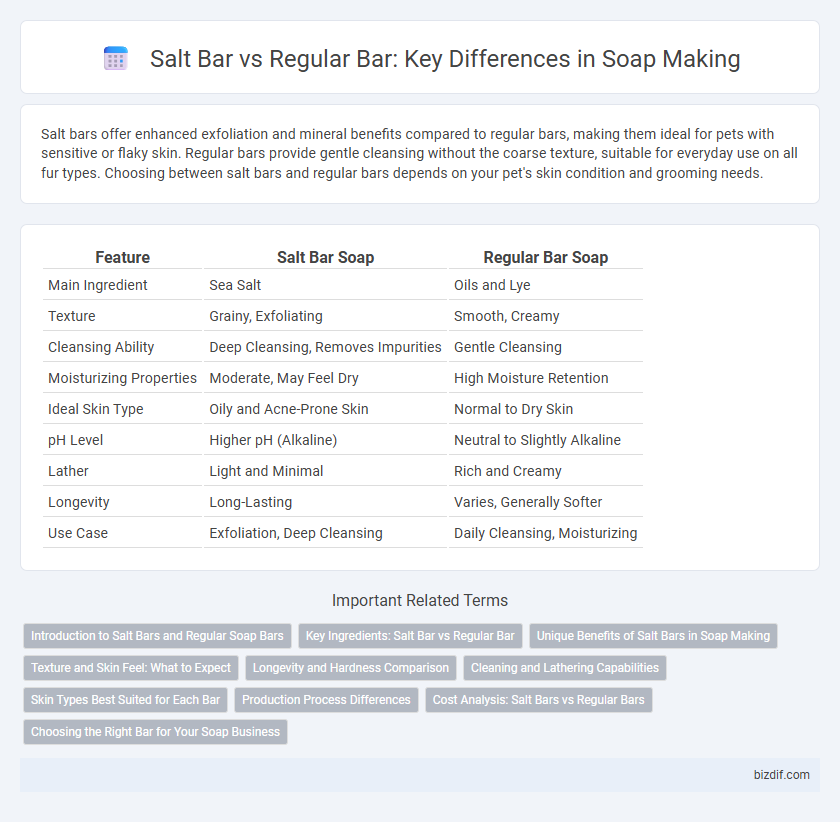Salt bars offer enhanced exfoliation and mineral benefits compared to regular bars, making them ideal for pets with sensitive or flaky skin. Regular bars provide gentle cleansing without the coarse texture, suitable for everyday use on all fur types. Choosing between salt bars and regular bars depends on your pet's skin condition and grooming needs.
Table of Comparison
| Feature | Salt Bar Soap | Regular Bar Soap |
|---|---|---|
| Main Ingredient | Sea Salt | Oils and Lye |
| Texture | Grainy, Exfoliating | Smooth, Creamy |
| Cleansing Ability | Deep Cleansing, Removes Impurities | Gentle Cleansing |
| Moisturizing Properties | Moderate, May Feel Dry | High Moisture Retention |
| Ideal Skin Type | Oily and Acne-Prone Skin | Normal to Dry Skin |
| pH Level | Higher pH (Alkaline) | Neutral to Slightly Alkaline |
| Lather | Light and Minimal | Rich and Creamy |
| Longevity | Long-Lasting | Varies, Generally Softer |
| Use Case | Exfoliation, Deep Cleansing | Daily Cleansing, Moisturizing |
Introduction to Salt Bars and Regular Soap Bars
Salt bars are a type of soap bar formulated with natural sea salt, known for their exfoliating properties and ability to provide a gentle cleanse while mineralizing the skin. Regular soap bars, typically made with a blend of oils, lye, and water, offer a wide range of formulations catered to different skin types and cleansing preferences. The unique inclusion of sea salt in salt bars enhances moisture retention and promotes skin detoxification compared to conventional soap bars.
Key Ingredients: Salt Bar vs Regular Bar
Salt bars primarily incorporate sea salt or Himalayan pink salt, enhancing exfoliation and improving lather stability, while regular bars typically rely on standard oils like olive, coconut, or palm oil for cleansing and moisturizing properties. The mineral content in salt bars boosts trace elements such as magnesium and calcium, promoting skin health, whereas regular bars emphasize glycerin retention for hydration. Surfactant blends differ as salt bars use natural salts to create a harder, longer-lasting texture, contrasting with the softer composition of regular bars made with synthetic or natural fats.
Unique Benefits of Salt Bars in Soap Making
Salt bars in soap making offer superior hardness and longevity compared to regular bars, making them ideal for extended use. The inclusion of sea salt enhances exfoliation and helps to balance skin oils, providing natural detoxification and improved skin texture. Salt bars also create a dense, creamy lather that is both moisturizing and cleansing, benefiting dry or sensitive skin types.
Texture and Skin Feel: What to Expect
Salt bars typically have a dense, exfoliating texture due to the high concentration of sea salt, which creates a slightly grainy feel on the skin, ideal for deep cleansing and revitalization. Regular bars offer a smoother, creamier lather with a gentler touch, making them suitable for sensitive skin and everyday use. The mineral-rich composition of salt bars can leave skin feeling firmer and more invigorated, whereas regular bars prioritize moisturizing properties for softness and hydration.
Longevity and Hardness Comparison
Salt bars exhibit significantly greater hardness and longevity compared to regular soap bars due to the inclusion of salt, which acts as a natural preservative and hardening agent. This increased density reduces the rate at which the soap dissolves during use, extending the lifespan of salt bars considerably. Regular bars, lacking this mineral infusion, tend to soften and wear down faster with frequent exposure to water.
Cleaning and Lathering Capabilities
Salt bars produce a denser, more exfoliating lather due to their higher sodium chloride content, which enhances their cleansing power and effectively removes dirt and oils. Regular soap bars, made primarily with oils and lye, generate a creamier, more moisturizing lather that is gentler on the skin while still providing adequate cleaning. Salt bars tend to last longer and offer a more invigorating scrub, whereas regular bars prioritize softness and hydration during cleansing.
Skin Types Best Suited for Each Bar
Salt bars, rich in mineral content from sea salt, are ideal for oily and acne-prone skin as they gently exfoliate and absorb excess oil, promoting a clearer complexion. Regular soap bars, formulated with moisturizing oils and butters, better suit dry or sensitive skin by providing hydration and minimizing irritation. Choosing between salt bars and regular bars depends on individual skin needs, ensuring optimal cleansing and skin health benefits.
Production Process Differences
Salt bars are produced by adding higher concentrations of salt during the saponification process, which causes the soap to gel and harden quickly, resulting in a denser and longer-lasting bar. Regular bars typically follow a standard cold or hot process without salt, emphasizing a creamy lather and softer texture. The inclusion of salt in salt bars alters the curing time and enhances the soap's longevity by reducing moisture content, while regular bars cure to preserve moisture for a gentler feel.
Cost Analysis: Salt Bars vs Regular Bars
Salt bars generally incur higher production costs due to the increased quantity of salt and specialized curing process needed for hardness and longevity. Regular bars typically have lower ingredient expenses but may require more frequent restocking, leading to higher long-term costs. Evaluating cost-effectiveness involves considering the initial expenditure against durability and usage frequency for soap.
Choosing the Right Bar for Your Soap Business
Salt bars offer increased hardness and a longer-lasting product compared to regular bars, making them ideal for customers seeking durability. Regular soap bars provide a smoother lather and are typically gentler on sensitive skin, appealing to a broader market segment. Selecting the right bar depends on your target audience's preferences and the desired benefits your soap business aims to highlight.
Salt Bar vs Regular Bar Infographic

 bizdif.com
bizdif.com